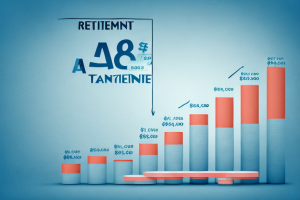In America, retirement savings are a critical aspect of financial planning. As individuals approach their golden years, it becomes increasingly important to have a clear understanding of how much money they will need to retire comfortably. However, there is no one-size-fits-all answer to this question, as retirement savings can vary significantly based on several factors, including income, age, and individual circumstances.
Understanding Retirement Savings in America
Retirement savings in America are influenced by a multitude of factors that impact an individual’s ability to save for their future. These factors include income level, employment status, access to employer-sponsored retirement plans, and individual financial habits and priorities. Additionally, external factors such as market volatility and economic conditions can also influence retirement savings.
Another important factor that can impact retirement savings in America is the level of financial literacy among individuals. Many Americans lack the necessary knowledge and understanding of personal finance to effectively plan and save for retirement. This can lead to poor financial decisions, inadequate savings, and increased reliance on social security benefits in retirement. Therefore, efforts to improve financial education and promote financial literacy are crucial in helping individuals make informed decisions and secure their financial future.
The Average Retirement Balance in the United States
When examining the average retirement balance in the United States, there are a few noteworthy statistics to consider. According to recent studies, the mean retirement savings for Americans in their 60s is around $172,000; however, it is essential to note that this figure can be misleading. This average is heavily skewed by a small percentage of individuals with exceptionally high retirement savings. When looking at median retirement savings, a more accurate representation, the figure for Americans in their 60s drops to around $58,000, highlighting a significant disparity among retirees.
It is important to understand the factors that contribute to this disparity in retirement savings. One key factor is the level of income and employment stability throughout one’s working years. Individuals with higher incomes and more stable employment tend to have higher retirement savings, while those with lower incomes and less stable employment struggle to save enough for retirement.
Another factor that affects retirement savings is the level of financial literacy and awareness among individuals. Many Americans lack the necessary knowledge and understanding of retirement planning and investment strategies, which can hinder their ability to save effectively for retirement.
Key Factors Affecting Americans’ Retirement Savings
Americans’ retirement savings are influenced by various factors, with some having a more significant impact than others. One crucial factor is income level. Individuals with higher incomes generally have more disposable income available for retirement savings. However, it is important to acknowledge that even those with lower incomes can save for retirement by making careful budgeting decisions and prioritizing long-term financial goals.
Another important factor that affects Americans’ retirement savings is the cost of living. The cost of living can vary significantly depending on the location, with some areas having higher expenses for housing, healthcare, and daily necessities. This can impact the amount of money individuals are able to save for retirement, as they may need to allocate a larger portion of their income towards basic living expenses.
Additionally, the level of financial literacy and education plays a significant role in retirement savings. Many Americans may not have a strong understanding of personal finance and retirement planning, which can lead to poor financial decisions and inadequate savings. It is crucial for individuals to educate themselves about retirement savings options, investment strategies, and the importance of starting early to maximize their savings potential.
Exploring the Retirement Savings Gap in America
The retirement savings gap refers to the difference between what individuals have saved for retirement and what they will actually need. Unfortunately, numerous Americans find themselves facing a significant retirement savings gap. With longer life expectancies and rising healthcare costs, it is essential to plan for a retirement that may extend several decades. To bridge the gap, individuals need to take proactive measures such as increasing savings contributions, exploring investment opportunities, and seeking professional financial advice.
One factor contributing to the retirement savings gap is the lack of financial literacy among Americans. Many individuals are not adequately educated about personal finance and retirement planning, leading to poor decision-making and inadequate savings. To address this issue, there is a growing need for financial education programs and resources that can empower individuals to make informed choices and take control of their retirement savings.
Another challenge in closing the retirement savings gap is the prevalence of debt among Americans. High levels of consumer debt, such as credit card debt and student loans, can hinder individuals’ ability to save for retirement. It is crucial for individuals to prioritize debt repayment and develop a strategy to manage and reduce their debt burden. By doing so, they can free up more funds to allocate towards retirement savings and ultimately narrow the retirement savings gap.
Retirement Savings: A Closer Look at the Numbers
When delving deeper into retirement savings figures, it is important to note that there are significant discrepancies based on age groups. For instance, individuals in their 40s have a median retirement savings balance of approximately $63,000, while those in their 50s have a median balance of around $117,000. These figures highlight the importance of starting retirement planning early to take full advantage of compound interest and allow savings to grow over time.
Analyzing Retirement Preparedness in the U.S.
Retirement preparedness in the United States is a topic of concern for many individuals. Studies suggest that a significant portion of Americans are not adequately prepared for retirement. In fact, research indicates that around 34% of non-retired adults have no retirement savings at all. This lack of preparedness underscores the importance of both education and personal financial responsibility when planning for retirement.
The Importance of Saving for Retirement: Statistics and Trends
Understanding the importance of saving for retirement is crucial to ensure a comfortable and secure future. Statistics show that individuals who start saving for retirement early have a significant advantage over those who delay. The power of compound interest allows savings to grow exponentially, making it easier to achieve retirement goals. Additionally, trends such as the gradual decline of pensions and the uncertain future of Social Security further emphasize the necessity of diligent retirement savings.
Retirement Savings Benchmarks to Strive For
While there is no one-size-fits-all retirement savings amount, there are several benchmarks that individuals can use as a guide. Traditional guidelines suggest aiming to save at least 10-15% of income for retirement. However, it is crucial to consider individual circumstances and adjust this figure accordingly. Working with a financial advisor can help determine specific retirement goals and create a personalized savings plan.
How Different Age Groups Fare with Retirement Savings
As mentioned earlier, different age groups have varying levels of retirement savings. Younger individuals, just starting their careers, may have lower savings balances due to various financial responsibilities. However, starting early and taking advantage of long-term investment strategies can help them catch up in later years. Older age groups may have higher savings balances, but they also face the challenge of saving enough to cover the expected length of retirement.
Examining the Impact of Income on Americans’ Retirement Nest Egg
Income plays a significant role in retirement savings. Those with higher incomes usually have more disposable income available for savings and may qualify for additional retirement contributions through employer-sponsored plans. However, all individuals, regardless of income, should strive to save for retirement and make the most out of the resources available to them.
Demographic Differences in Retirement Savings Habits
Retirement savings habits can vary among different demographics. Factors such as education, gender, and geographic location may influence savings behaviors. For example, studies have shown that individuals with higher levels of education tend to have higher retirement savings. Additionally, men generally have higher retirement account balances than women, highlighting the need for addressing gender disparities in retirement savings.
Exploring Employer-Sponsored Retirement Plans and Contributions
Employer-sponsored retirement plans, such as 401(k)s, are essential tools for retirement savings. These plans provide individuals with an opportunity to contribute a portion of their income to a retirement account on a pre-tax basis. Furthermore, employers often match a percentage of the employee’s contributions, effectively increasing the amount of savings over time. Taking full advantage of employer-sponsored plans is crucial to maximizing retirement savings.
The Role of Social Security Benefits in Americans’ Retirement Income
Social Security benefits play a vital role in Americans’ retirement income. These benefits provide a safety net to individuals who have contributed to the system throughout their working years. However, it is important to keep in mind that Social Security alone may not be sufficient to maintain a comfortable retirement lifestyle. Therefore, it is crucial to have additional retirement savings to supplement Social Security benefits.
Common Mistakes to Avoid When Saving for Retirement
When saving for retirement, there are several common mistakes that individuals should avoid. One common error is not starting early enough. The power of compound interest makes a significant difference over time, so delaying retirement savings can have a substantial impact on the final savings balance. Other mistakes include not contributing enough to retirement accounts, prematurely withdrawing funds, and not reassessing retirement goals and savings strategies periodically.
Strategies to Maximize Your Retirement Savings Potential
Maximizing retirement savings potential requires careful planning and consistent effort. One strategy is to automate contributions to retirement accounts, allowing for consistent and disciplined saving. Additionally, increasing contributions whenever possible, taking advantage of employer matches, and exploring various investment options can help grow retirement savings over time. Regularly reviewing and adjusting the retirement savings strategy is also essential as circumstances change.
Navigating Market Volatility and Its Impact on Retirement Funds
Market volatility is an inevitable aspect of investing. However, it can have a significant impact on retirement funds, especially for individuals nearing retirement age. Proper asset allocation, diversification, and periodic rebalancing can help mitigate the effects of market volatility. Additionally, working with a financial advisor helps develop a long-term investment strategy that aligns with retirement goals and risk tolerance.
Balancing Short-Term Financial Goals with Long-Term Retirement Planning
One challenge individuals face when saving for retirement is balancing short-term financial goals with long-term retirement planning. While saving for retirement is crucial, it is also important to address immediate financial needs and build an emergency fund. Striking a balance between short-term and long-term goals can help individuals avoid excessive debt and maintain financial stability throughout their working years.
Exploring Alternative Investment Options for Boosting Your Nest Egg
While traditional retirement accounts such as 401(k)s and IRAs are popular options for retirement savings, exploring alternative investment options can further boost an individual’s nest egg. This may include real estate investments, individual stock portfolios, or alternative retirement savings vehicles. However, it is essential to assess the risks involved and seek professional advice before branching out into alternative investments.
The Importance of Regularly Reviewing Your Retirement Plan
Finally, regularly reviewing and reassessing your retirement plan is crucial to ensure it remains aligned with your goals and financial circumstances. Life events, such as marriage, having children, or changes in employment, can significantly impact retirement planning. By regularly revisiting and adjusting your retirement plan, you can ensure that it continues to be a roadmap to a well-funded retirement.



